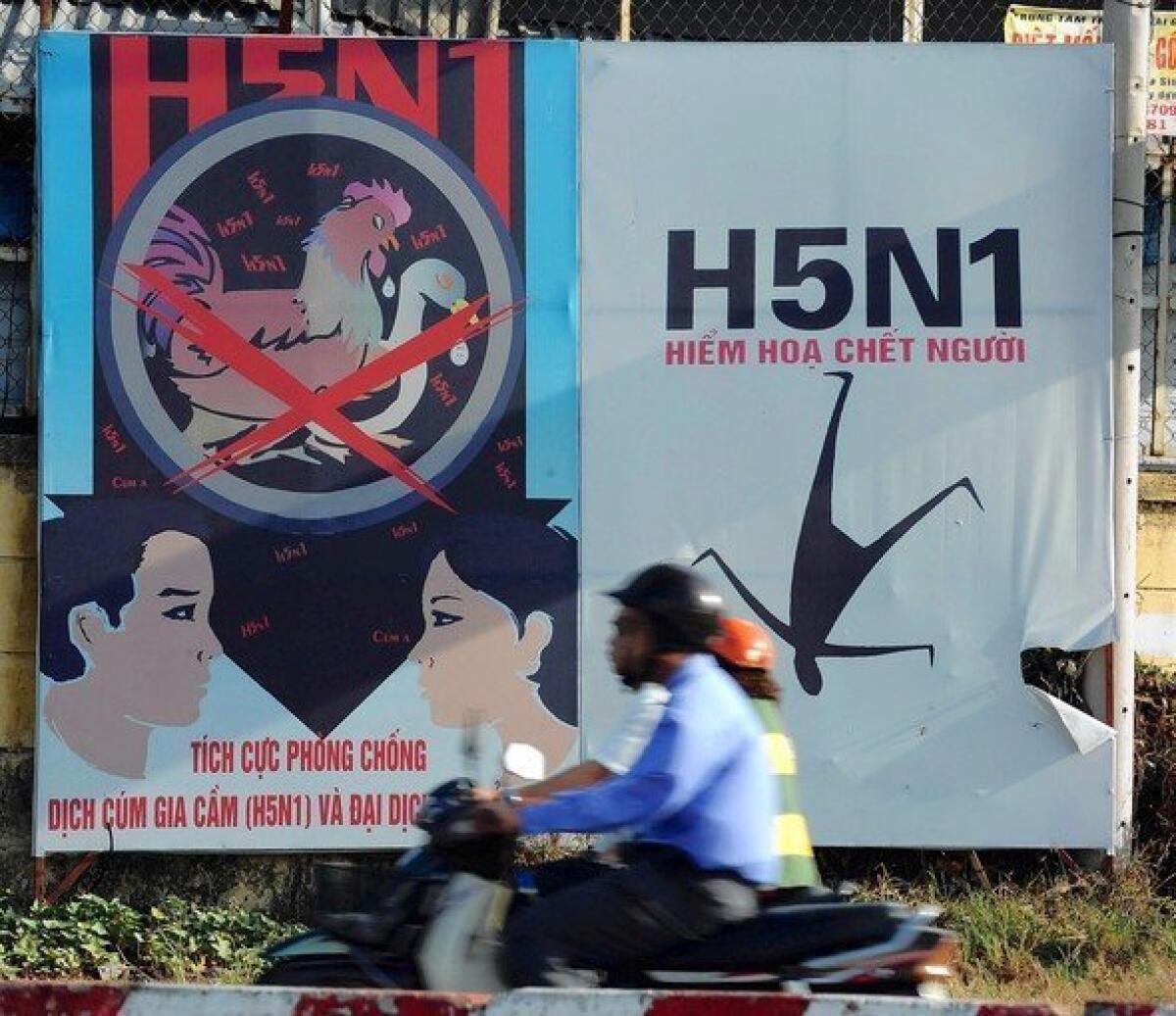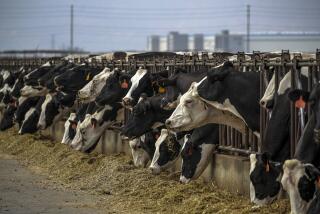Scientists create bird flu that spreads easily among mammals

- Share via
Scientists have created versions of the H5N1 bird flu that spread easily among mammals through droplets in sneezes and have concluded that it is certainly possible the deadly virus could trigger a global pandemic in humans.
Writing in Friday’s edition of the journal Science, Dutch researchers laid out for their fellow scientists — and the public — precisely how they engineered bird flu strains that were contagious in ferrets, laboratory animals often used as proxies for people in influenza research. As few as five mutations, generated by passing the virus from ferret to ferret to ferret just 10 times, may be enough to allow the bug to infect new hosts through the air, said virologist Ron Fouchier, lead author of the controversial report.
“We assume also in humans it would only take a low number of transmission events for these mutations to accumulate,” he said.
The publication of the team’s work — after a six-month delay prompted by a U.S. government biosecurity panel — ends a high-profile chapter in the debate over so-called dual-use research of concern: experiments that serve a legitimate scientific purpose but also could pose a threat to public health, the environment or national security.
At the same time, the study ushers in a new and uncertain era for the study of such dangerous agents as bird flu, anthrax and Ebola virus. Experts said they expected continued wrangling over what research should be conducted, by whom, and under what closely monitored restrictions.
“It’s still unclear, once research is identified as dual-use research of concern, what happens next,” said Richard Webby, a flu researcher at St. Jude Children’s Research Hospital in Memphis, Tenn., who was not involved with Fouchier’s paper but supported his efforts. “Is there an appropriate strategy for mitigating risk other than ‘Don’t do the research?’ ”
For bird flu, that has been a difficult question to answer.
The pathogen has killed millions of birds. It has also been deadly, if rare, in humans. The World Health Organization has confirmed 606 cases of H5N1 infection in people since 2003. Nearly 60% of those cases were fatal, suggesting that the virus has the potential to wipe out millions of people if it became widespread.
Thus far, humans haven’t caught H5N1 easily. But virologists like Fouchier wanted to know whether that might change.
Working in high-security laboratories, Fouchier and his colleagues at Erasmus Medical Center in Rotterdam took an H5N1 strain isolated from a human in Indonesia and added three mutations thought to have helped fuel global flu pandemics in 1918, 1957 and 1968.
The researchers infected ferrets with the engineered H5N1 by squirting it into their noses. The changes in the virus increased the viral load in the ferrets’ upper respiratory tracts but didn’t make the pathogen contagious through droplets. Neither did adding a fourth mutation.
So the team next allowed the virus to mutate inside the ferrets’ bodies. They took samples from the noses of infected animals and used them to infect others. After 10 passes, the virus had acquired enough changes to pass through the air between ferrets in adjacent cages.
The animals infected by airborne droplets suffered lethargy and loss of appetite, but they did not die from their illnesses.
In a companion study also published in Science, researchers tried to assess the likelihood that the combinations of mutations identified in Fouchier’s experiments — as well as genetic changes seen in a similar H5N1 ferret experiment by University of Wisconsin researcher Yoshihiro Kawaoka — might arise on their own.
Derek Smith, an infectious disease researcher at the University of Cambridge in England, and colleagues looked at H5N1 strains already circulating in birds and humans to figure out how many key mutations each strain might require to infect mammals through the air. They also developed a computer model to examine the biological factors influencing whether those mutations could evolve in a host during a five-day flu infection.
With so many unknowns about H5N1, Smith’s team didn’t arrive at an absolute measurement of risk. But the study points to factors virologists and epidemiologists should track as they continue to monitor the virus.
Smith compared the H5N1 threat to the earthquake risk posed by the San Andreas fault. “It really is real, but we just don’t know how real yet,” he said. “What we know from our study is that it’s active and it could go off.”
It will take more experiments like Fouchier’s to find additional triggers and assess the risk more precisely, Smith added.
But part of the legacy of Fouchier’s research, as well as Kawaoka’s, could be to slow the progress of such dual-use projects.
Many people are afraid that scientists could create a pathogen that, by accident or through deliberate acts, could escape from the lab and sicken millions. Some still worry that publishing the details of such studies — a key part of the scientific process — amounts to hand-delivering a recipe for a potent bioweapon to technologically proficient terrorists.
In the months since the U.S. National Science Advisory Board for Biosecurity first asked for the studies to be amended before publication, scientists have adhered to a self-imposed moratorium on such research — and they’re still struggling to figure out how to lift it, said Dr. Anthony Fauci, director of the National Institute of Allergy and Infectious Diseases, which funded both H5N1 studies.
U.S. officials issued a policy in March requiring federal agencies that fund or conduct biological research to report to the Assistant to the President for Homeland Security and Counterterrorism when they have experiments underway that qualify as dual-use research of concern. Researchers also must develop plans to limit risks, but the policy doesn’t lay out how those plans should be assembled.
“In the abstract, it’s easy to say we need to mitigate the risk,” said Carrie Wolinetz, a vice president at the Assn. of American Universities, which lobbies for increased research funding. “But where this plays out in terms of research processes is difficult to figure out.”
In one of several commentaries that accompany the Science papers, Wolinetz pointed out that the new policy wouldn’t have covered some notorious dual-use experiments from the past, including an Australian study that inadvertently increased the virulence of mousepox and thus revealed how the same might be done for smallpox.
Mark Frankel, director of the Scientific Responsibility, Human Rights and Law Program at the American Assn. for the Advancement of Science (which publishes Science), worried that more red tape would discourage researchers from pursuing H5N1 work. The publication of Fouchier’s paper was delayed in part because the Dutch government made him apply for permission to submit his work to Science, on the grounds that the research should be regulated as the export of weapons technology, he wrote in one of the other commentaries.
The U.S. government isn’t finished addressing H5N1 research and plans to release additional guidelines to help research institutions manage the risks of dual-use research of concern, Fauci said.
In his view, he added, the benefit of studying H5N1 “far outweighs” any potential danger.
There’s risk in everything in life, he said.







